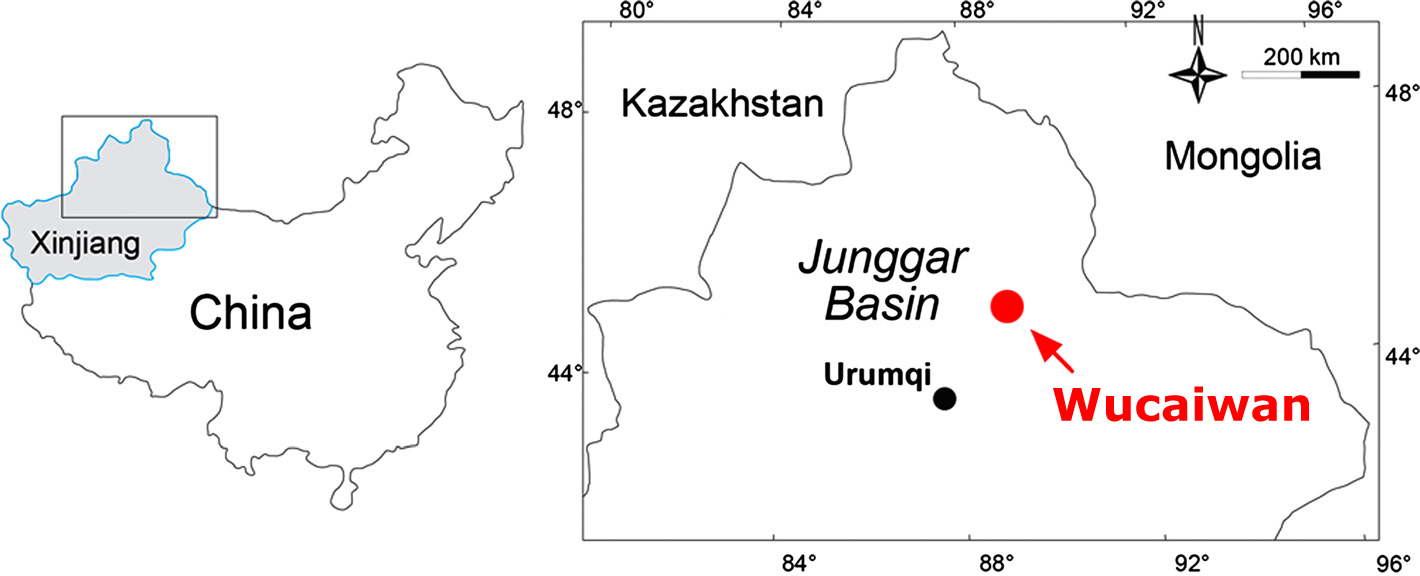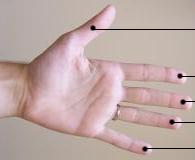|
Limusaurus
''Limusaurus'' is a genus of theropod dinosaur that lived in what is now China during the Late Jurassic, around 161 to 157 million years ago. The type and only species ''Limusaurus inextricabilis'' was described in 2009 from specimens found in the Upper Shishugou Formation in the Junggar Basin of China. The genus name consists of the Latin words for "mud" and "lizard", and the species name means "impossible to extricate", both referring to these specimens possibly dying after being mired. ''Limusaurus'' was a small, slender animal, about in length and in weight, which had a long neck and legs but very small forelimbs (with reduced first and fourth fingers). It underwent a drastic morphological transformation as it aged: while juveniles were toothed, these teeth were completely lost and replaced by a beak with age. Several of these features were convergently similar to the later ornithomimid theropods as well as the earlier non-dinosaurian shuvosaurids. ''Limusauru ... [...More Info...] [...Related Items...] OR: [Wikipedia] [Google] [Baidu] |
Noasauridae
Noasauridae is an extinct family of theropod dinosaurs belonging to the group Ceratosauria. They were closely related to the short-armed abelisaurids, although most noasaurids had much more traditional body types generally similar to other theropods. Their heads, on the other hand, had unusual adaptations depending on the subfamily. 'Traditional' noasaurids, sometimes grouped in the subfamily Noasaurinae, had sharp teeth which splayed outwards from a downturned lower jaw. The most complete and well-known example of these kinds of noasaurids was '' Masiakasaurus knopfleri'' from Madagascar. Another group, Elaphrosaurinae, has also been placed within Noasauridae by some studies. Elaphrosaurines developed toothless jaws and herbivorous diets, at least as adults. The most complete and well known elaphrosaurine was '' Limusaurus inextricabilis''. At least some noasaurids had pneumatised cervical vertebrae.Arthur Souza Brum, Elaine Batista Machado, Diogenes de Almeida Campos & Al ... [...More Info...] [...Related Items...] OR: [Wikipedia] [Google] [Baidu] |
Ceratosauria
Ceratosaurs are members of the clade Ceratosauria, a group of dinosaurs defined as all theropods sharing a more recent common ancestor with '' Ceratosaurus'' than with birds. The oldest known ceratosaur, '' Saltriovenator'', dates to the earliest part of the Jurassic, around 199 million years ago. According to the majority of the latest research, Ceratosauria includes three major clades: Ceratosauridae, Noasauridae, and Abelisauridae, found primarily (though not exclusively) in the Southern Hemisphere. Originally, Ceratosauria included the above dinosaurs plus the Late Triassic to Early Jurassic Coelophysoidea and Dilophosauridae, implying a much earlier divergence of ceratosaurs from other theropods. However, most recent studies have shown that coelophysoids and dilophosaurids do not form a natural group with other ceratosaurs, and are excluded from this group. Ceratosauria derives its names from the type species, '' Ceratosaurus nasicornis'', described by O.C. Marsh in 1 ... [...More Info...] [...Related Items...] OR: [Wikipedia] [Google] [Baidu] |
Ceratosaur
Ceratosaurs are members of the clade Ceratosauria, a group of dinosaurs defined as all theropods sharing a more recent common ancestor with ''Ceratosaurus'' than with birds. The oldest known ceratosaur, '' Saltriovenator'', dates to the earliest part of the Jurassic, around 199 million years ago. According to the majority of the latest research, Ceratosauria includes three major clades: Ceratosauridae, Noasauridae, and Abelisauridae, found primarily (though not exclusively) in the Southern Hemisphere. Originally, Ceratosauria included the above dinosaurs plus the Late Triassic to Early Jurassic Coelophysoidea and Dilophosauridae, implying a much earlier divergence of ceratosaurs from other theropods. However, most recent studies have shown that coelophysoids and dilophosaurids do not form a natural group with other ceratosaurs, and are excluded from this group. Ceratosauria derives its names from the type species, ''Ceratosaurus nasicornis'', described by O.C. Marsh in 1884. ... [...More Info...] [...Related Items...] OR: [Wikipedia] [Google] [Baidu] |
Shishugou Formation
The Shishugou Formation () is a geological formation in Xinjiang, China. Its strata date back to the Late Jurassic period. Dinosaur remains are among the fossils that have been recovered from the formation.Weishampel, David B; et al. (2004). "Dinosaur distribution (Late Jurassic, Asia)." In: Weishampel, David B.; Dodson, Peter; and Osmólska, Halszka (eds.): The Dinosauria, 2nd, Berkeley: University of California Press. Pp. 550–552. . The Shishugou Formation is considered one of the most phylogenetically and trophically diverse Middle to Late Jurassic theropod fauna. The Wucaiwan Member, once considered a separate, underlying formation,Weishampel, David B; et al. (2004). "Dinosaur distribution (Middle Jurassic, Asia)." In: Weishampel, David B.; Dodson, Peter; and Osmólska, Halszka (eds.): The Dinosauria, 2nd, Berkeley: University of California Press. Pp. 541–542. . is now considered the lowest unit of the Shishugou Formation. Lithology At the Wuwaican locality, the format ... [...More Info...] [...Related Items...] OR: [Wikipedia] [Google] [Baidu] |
Elaphrosaurus
''Elaphrosaurus'' ( ) is a genus of ceratosaurian theropod dinosaur that lived approximately 154 to 150 million years ago during the Late Jurassic Period in what is now Tanzania in Africa. ''Elaphrosaurus'' was a medium-sized but lightly built member of the group that could grow up to long. Morphologically, this dinosaur is significant in two ways. Firstly, it has a relatively long body but is very shallow-chested for a theropod of its size. Secondly, it has very short hindlimbs in comparison with its body. Phylogenetic analyses indicate that this genus is likely a ceratosaur. Earlier suggestions that it is a late surviving coelophysoid have been examined but generally dismissed. ''Elaphrosaurus'' is currently believed to be a very close relative of '' Limusaurus'', an unusual beaked ceratosaurian which may have been either herbivorous or omnivorous. Discovery The type specimen of ''Elaphrosaurus bambergi'' HMN Gr.S. 38–44 was recovered in the Middle Dinosaur Memb ... [...More Info...] [...Related Items...] OR: [Wikipedia] [Google] [Baidu] |
Xu Xing (paleontologist)
Xu Xing (; born July 1969) is a Chinese paleontologist who has named more dinosaurs than any other living paleontologist. Such dinosaurs include the Jurassic ceratopsian '' Yinlong'', the Jurassic tyrannosauroid ''Guanlong'', the large oviraptorosaur ''Gigantoraptor'', and the troodontid ''Mei''. Biography Xing was born in Xinjiang, China, in 1969. A graduate from the department of geology of Peking University, he is currently a researcher at the Institute of Vertebrate Paleontology and Paleoanthropology of the Chinese Academy of Sciences in Beijing. He had originally planned to become an economist. However, he was assigned to the department of geology by the Chinese authorities. He graduated in 1995, and claims inspiration from Roy Chapman Andrews Roy Chapman Andrews (January 26, 1884 – March 11, 1960) was an American explorer, adventurer and naturalist who became the director of the American Museum of Natural History. He led a series of expeditions through the politi ... [...More Info...] [...Related Items...] OR: [Wikipedia] [Google] [Baidu] |
Digit (anatomy)
A digit is one of several most distal parts of a limb, such as fingers or toes, present in many vertebrates. Names Some languages have different names for hand and foot digits (English: respectively " finger" and " toe", German: "Finger" and "Zeh", French: "doigt" and "orteil"). In other languages, e.g. Arabic, Russian, Polish, Spanish, Portuguese, Italian, Czech, Tagalog, Turkish, Bulgarian, and Persian, there are no specific one-word names for fingers and toes; these are called "digit of the hand" or "digit of the foot" instead. In Japanese, yubi (指) can mean either, depending on context. Human digits Humans normally have five digits on each extremity. Each digit is formed by several bones called phalanges, surrounded by soft tissue. Human fingers normally have a nail at the distal phalanx. The phenomenon of polydactyly occurs when extra digits are present; fewer digits than normal are also possible, for instance in ectrodactyly. Whether such a mutation ca ... [...More Info...] [...Related Items...] OR: [Wikipedia] [Google] [Baidu] |
Bone Beds
A bone bed is any geological stratum or deposit that contains bones of whatever kind. Inevitably, such deposits are sedimentary in nature. Not a formal term, it tends to be used more to describe especially dense collections such as Lagerstätte. It is also applied to brecciated and stalagmitic deposits on the floor of caves, which frequently contain osseous remains. In a more restricted sense, the term is used to describe certain thin layers of bony fragments, which occur in well-defined geological strata. One of the best-known of these is the Ludlow Bone Bed, which is found at the base of the Downton Sandstone in the Upper Ludlow series. At Ludlow (England) itself, two such beds are actually known, separated by about . of strata. Although quite thin, the Ludlow Bone Bed can be followed from that town into Gloucestershire, for a distance of . It is almost completely made up of fragments of spines, teeth and scales of ganoid fish. Another well-known bed, formerly known as the B ... [...More Info...] [...Related Items...] OR: [Wikipedia] [Google] [Baidu] |
Xinjiang
Xinjiang, SASM/GNC: ''Xinjang''; zh, c=, p=Xīnjiāng; formerly romanized as Sinkiang (, ), officially the Xinjiang Uygur Autonomous Region (XUAR), is an autonomous region of the People's Republic of China (PRC), located in the northwest of the country at the crossroads of Central Asia and East Asia. Being the largest province-level division of China by area and the 8th-largest country subdivision in the world, Xinjiang spans over and has about 25 million inhabitants. Xinjiang borders the countries of Mongolia, Russia, Kazakhstan, Kyrgyzstan, Tajikistan, Afghanistan, Pakistan and India. The rugged Karakoram, Kunlun and Tian Shan mountain ranges occupy much of Xinjiang's borders, as well as its western and southern regions. The Aksai Chin and Trans-Karakoram Tract regions, both administered by China, are claimed by India. Xinjiang also borders the Tibet Autonomous Region and the provinces of Gansu and Qinghai. The most well-known route of the historic Silk Road ... [...More Info...] [...Related Items...] OR: [Wikipedia] [Google] [Baidu] |
Dzungaria
Dzungaria (; from the Mongolian words , meaning 'left hand') is a geographical subregion in Northwest China that corresponds to the northern half of Xinjiang. It is thus also known as Beijiang, which means "Northern Xinjiang". Bounded by the Altai Mountains to the north and the Tian Shan mountain range to the south, Dzungaria covers approximately , and borders Kazakhstan to the west and Mongolia to the east. In contexts prior to the mid-18th century Dzungar genocide, the term "Dzungaria" could cover a wider area, conterminous with the Oirat-led Dzungar Khanate. Although Dzungaria is geographically, historically, and ethnically distinct from the Tarim Basin (or Nanjiang, ), the Manchu-led Qing dynasty integrated both areas into one province, Xinjiang. Dzungaria is Xinjiang's center of heavy industry, generates most of the region's GDP, and houses its political capital Ürümqi ( Oirat for 'beautiful pasture'). As such, Dzungaria continues to attract intraprovincial and inte ... [...More Info...] [...Related Items...] OR: [Wikipedia] [Google] [Baidu] |
Sauropod
Sauropoda (), whose members are known as sauropods (; from '' sauro-'' + '' -pod'', 'lizard-footed'), is a clade of saurischian ('lizard-hipped') dinosaurs. Sauropods had very long necks, long tails, small heads (relative to the rest of their body), and four thick, pillar-like legs. They are notable for the enormous sizes attained by some species, and the group includes the largest animals to have ever lived on land. Well-known genera include '' Brachiosaurus'', '' Diplodocus'', ''Apatosaurus'' and '' Brontosaurus''. The oldest known unequivocal sauropod dinosaurs are known from the Early Jurassic. '' Isanosaurus'' and '' Antetonitrus'' were originally described as Triassic sauropods, but their age, and in the case of ''Antetonitrus'' also its sauropod status, were subsequently questioned. Sauropod-like sauropodomorph tracks from the Fleming Fjord Formation (Greenland) might, however, indicate the occurrence of the group in the Late Triassic. By the Late Jurassic (150 mil ... [...More Info...] [...Related Items...] OR: [Wikipedia] [Google] [Baidu] |








